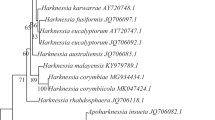Abstract
Cryptosporiopsis eucalypti has been associated with foliar disease of eucalypts in many parts of the world, especially in South-East Asia where Eucalyptus camaldulensis can be severely affected. In a field trial in southern Vietnam of 150 open-pollinated families of seven tropical provenances of E. camaldulensis, C. eucalypti was the main pathogen associated with leaf blight and crown dieback. Variation in susceptibility to foliar disease occurred at the family, provenance and sub-species levels offering excellent opportunities for selection of resistant trees. Pathogenicity tests using seedlings have shown that the fungus can infect stems as well as leaves. Stem inoculation may offer opportunities for rapid screening for resistant germplasm, but a connection between the results of such tests and field performance has not been made.
Similar content being viewed by others
References
Ahlich K, Sieber TN (1996) The profusion of dark septate fungi in non-ectomycorrhizal fine roots of forest trees and shrubs. New Phytologist 132, 259–270.
Booth TH, Jovanovic T, Old KM, Dudzinski MJ (2000) Climatic mapping to identify high risk areas for Cylindrocladium quinqueseptatum leaf blight on eucalypts in mainland South East Asia and around the world. Environmental Pollution 108, 365–372.
Ciesla WM, Diekman M, Putter CAJ (1996) ‘FAO/IPGRI Technical guidelines for the safe movement of germplasm. No. 17. Eucalyptus spp.’ (FAO-IPGRI: Rome)
Dhingra OD, Sinclair JB (1985) ‘Basic plant pathology methods.’ (CRC Press: Boca Raton)
Espinosa-Garcia FJ, Langenheim JH (1990) The endophytic fungal community in leaves of a coastal redwood population—diversity and spatial patterns. New Phytologist 116, 89–97.
Ferreira FA, Silveira SF, Alfenas AC, Demuner, AM (1998) Manchade-criptoriopsis em eucalipto no Brasil. [Eucalyptus leaf spot in Brazil caused by Cryptosporiopsis eucalypti]. Fitopatologia Brasileira 23, 414.
Gadgil PD, Dick M (1999) Fungi silvicolae Novazelandiae: 2. New Zealand Journal of Forest Science 29, 440–458.
Johnston PR, Fullerton, RA (1988) Cryptosporiopsis citri sp. nov., cause of a citrus leaf spot in the Pacific Islands. New Zealand Journal of Experimental Agriculture 16, 159–163.
Kaneko S, Sakamoto Y, Kiyohara T (1996) Biological characteristics of Cryptosporiopsis abietina on hinoki cypress and its antagonistic effect to other microorganisms. Mycoscience 37, 391–399.
Kobayashi T, Hayashi H, Kubono T, Tabata M, Ito S (1990) Etiological and pathological studies on the resinous stem canker of hinoki cypress, Chamaecyparis obtusa Sieb, et Zucc. I. Detection, identification and pathogenicity of the causal fungus. Bulletin of Forestry and Forest Products Research Institute, Ibaraki 357, 51–93.
Lee SS (1999) Forest health in plantation forests in South-East Asia. Australasian Plant Pathology 28, 283–291.
McKenzie EHC, Buchanan PK, Johnston PR (1999) Fungi on pohutukawa and other Metrosideros species in New Zealand. New Zealand Journal of Botany 37, 335–354.
Midgley SJ, Pinyopusarerk K (1996) The role of eucalypts in local development in the emerging economies of China, Viet Nam and Thailand. In ‘Environmental management: the role of eucalypts and other fast growing species’. (Eds KG Eldridge, MP Crowe, KM Old) pp. 4–10. (CSIRO: Canberra)
Old KM, Ivory MH (1999) Pathogen threats to short rotation forest plantations in South East Asia and options for management. In ‘Tropical plant protection in the information age’. Proceedings Fifth International Conference, pp. 153–157. (Malaysian Plant Protection Society: Kuala Lumpur)
Rommert AK (1998) Pezicula: endophyte, mutualist and weak pathogen. In ‘Proceedings of the seventh international congress of plant pathology, Edinburgh, August 1998’. Abstract No. 2.9.12.
Sankaran KV, Sutton BC, Balasundaran M (1995) Cryptosporiopsis eucalypti sp.nov, causing leaf spots of eucalypts in Australia, India and USA. Mycological Research 99, 827–830.
Sharma JK, Mohanan C (1982) Cylindrocladium spp. associated with various diseases of Eucalyptus in Kerala. European Journal of Forest Pathology 12, 129–136.
Sieber TN, Dorworth CE (1994) An ecological study about assemblages of endophytic fungi in Acer macrophyllum in British Columbia: in search of candidate mycoherbicides. Canadian Journal of Botany 12, 1397–1402.
Smith H, Wingfield M J, Crous PW, Coutinho TA (1996) Sphaeropsis sapinea and Botryosphaeria dothidea endophytic in Pinus spp. and Eucalyptus spp. in South Africa. South African Journal of Botany 62, 86–88.
Verkley GJM (1999) A monograph of the genus Pezicula and its anamorphs. Studies in Mycology 44, 1–180.
Author information
Authors and Affiliations
Corresponding author
Rights and permissions
About this article
Cite this article
Old, K.M., Dudzinski, M.J., Pongpanich, K. et al. Cryptosporiopsis leaf spot and shoot blight of eucalypts. Australasian Plant Pathology 31, 337–344 (2002). https://doi.org/10.1071/AP02037
Received:
Accepted:
Issue Date:
DOI: https://doi.org/10.1071/AP02037




